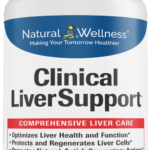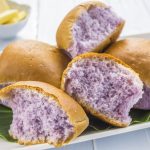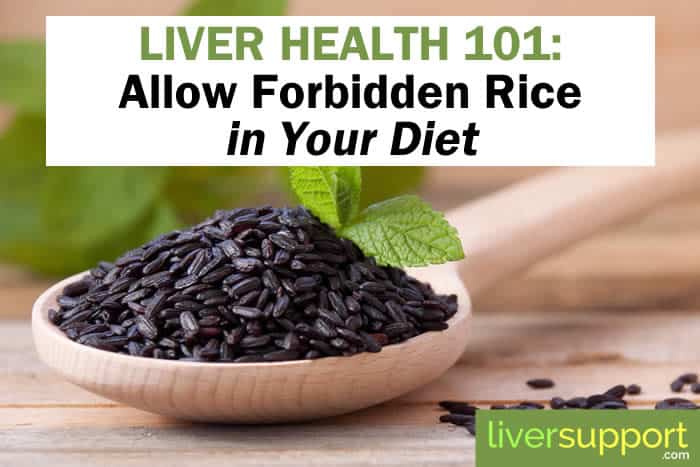
Previous
Cyramza Delivers New Hope for Patients with Liver Cancer

Next
Polycystic Ovaries Frequently Occur with a Fatty Liver
Liver Health 101: Allow Forbidden Rice in Your Diet
Forbidden rice has transitioned from being a forbidden food in ancient China to a recommended one for anyone wanting dietary liver support.
As gluten-free and Paleo diets become mainstream, the newest trend in healthful eating seems to be shunning all starches. Although these dietary strategies might benefit some individuals, there are exceptions. This is because not all carbohydrates are created equally. In fact, some starches are absolutely healthy. Packed with nutritional value and containing potent benefits for liver wellness, forbidden rice is an example of a ‘starch’ that should be welcomed.
An ancient grain that has been eaten in regions of Asia for thousands of years, forbidden rice is one of over 40,000 varieties of rice. Scholars believe that this variety was exclusive; only the top echelon of ancient Chinese society was allowed to eat it. Noble Chinese men took possession of every grain of forbidden rice and banned its consumption for those who were not royalty or very wealthy. The crop was reserved for the highest elite class of Chinese people. Hence, the name “forbidden rice” was termed.
Also called black rice or purple rice, forbidden rice is nutritionally superior to its relatives. When comparing black rice with the brown and white versions, the differences are staggering:
- White Rice – In 100 mg of uncooked white rice, there is 6.8 grams of protein and 0.6 grams of fiber.
- Brown Rice – In 100 mg of uncooked brown rice, there is 7.9 grams of protein and 2.9 grams of fiber.
- Black Rice – In 100 mg of uncooked black rice, there is 8.5 grams of protein and 4.9 grams of fiber.
In addition, forbidden rice contains anthocyanins, which are not found in brown or white rice. As powerful, disease-fighting antioxidants, anthocyanins give foods like black rice and blueberries their dark, purplish color.
Forbidden Rice Is Good for Your Liver
A food that is high in protein and fiber is bound to be a healthful dietary staple. This is especially true for supporting liver health. A few liver-centric properties of the antioxidants in forbidden rice include:
- Maintain healthy cells – Anthocyanins help regulate the destruction of cancer cells in the body and quell inflammation. These are desirable traits in those with a liver ailment that hope to reduce liver cell inflammation and prevent the development of liver cancer.
- Help liver cell renewal – The anthocyanins in forbidden rice help restore the health of your liver, and may even help with doing so after it has been damaged by alcohol consumption. This is another desirable trait because it appears that the antioxidants in forbidden rice can assist with healthy liver cell regeneration.
- Reduce fat cells in your liver – By modulating the activities of hepatic lipogenic enzymes, research has demonstrated that an extract of anthocyanins in forbidden rice can reduce excess accumulation of fat in your liver. For the estimated 30 percent of American adults with excess fat in their liver, this enzyme modulation can help prevent the development or progression of a fatty liver.
Clinical LiverSupport can also help reduce fat accumulation in your liver. In fact, this comprehensive liver care supplement has also been touted to protect and produce new liver cells, as well as reduce inflammation in your liver and throughout your body.
can also help reduce fat accumulation in your liver. In fact, this comprehensive liver care supplement has also been touted to protect and produce new liver cells, as well as reduce inflammation in your liver and throughout your body.
Containing a slightly chewy texture and a delicious nutty flavor, forbidden rice does not need to be saved for our society’s top one percent. Although still grown in small batches, forbidden rice’s popularity (and thus its availability) is on the rise. Its unique nutritional profile makes it ideal for those concerned with their liver’s wellness. Because forbidden rice is anti-carcinogenic, anti-inflammatory, supports liver cell renewal, and protects against liver fat accumulation, this dark colored rice is invited to grace the plates of all who want a healthy liver.
 Editor’s Note: If you’re not a fan of rice, but a BIG fan of bread, you might be interested to know about purple bread. Anthocyanins extracted from black rice have been added to bread in order to create bread that is digested up to 20% slower – reducing the glycemic index. This process leaves behind the rice starches but, due to the effects of the anthocyanins (inhibiting the digestive enzymes), it is still digested slower than regular bread. This is an exciting finding for those battling obesity or diabetes, as this bread may be much more manageable as part of a regular diet. Learn more about this superfood.
Editor’s Note: If you’re not a fan of rice, but a BIG fan of bread, you might be interested to know about purple bread. Anthocyanins extracted from black rice have been added to bread in order to create bread that is digested up to 20% slower – reducing the glycemic index. This process leaves behind the rice starches but, due to the effects of the anthocyanins (inhibiting the digestive enzymes), it is still digested slower than regular bread. This is an exciting finding for those battling obesity or diabetes, as this bread may be much more manageable as part of a regular diet. Learn more about this superfood.
https://draxe.com/forbidden-rice/, The Forbidden Rice: Black Rice Nutrition and Benefits, Retrieved March 18, 2018, Dr. Axe, 2018.
https://www.care2.com/greenliving/what-is-forbidden-rice-and-is-it-healthy.html, What is Forbidden Rice and Is It Healthy?, Michelle Schoffro Cook, Retrieved March 10, 2018, care2.com, Inc., 2018.
https://www.ncbi.nlm.nih.gov/pubmed/23471845, Hypolipidaemic effects of cyanidin 3-glucoside rich extract from black rice through regulating hepatic lipogenic enzyme activities, Um MY et al, Retrieved March 10, 2018, Journal of the Science of Food and Agriculture, September 2013.
https://www.ncbi.nlm.nih.gov/pubmed/28858891, Recent advances of bioactivities of black rice, Dias ALS, et al, 10, 2018, Retrieved March Current Opinion in Clinical Nutrition and Metabolic Care, November 2017.






